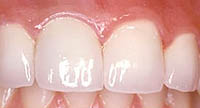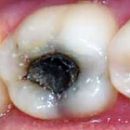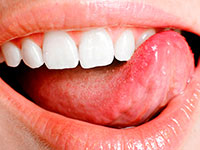Ceramic Vinir - Thin Facing, 0.5-0.7 mm thick, covering the front surface of the tooth. Like any of the methods of treatment and cosmetic correction of teeth, has its pros and cons. Learn more about Vinir!
Content
Toothpipes
 Ceramic Vinir - Thin Facing, 0.5-0.7 mm thick, covering the front surface of the tooth.
Ceramic Vinir - Thin Facing, 0.5-0.7 mm thick, covering the front surface of the tooth.
Viniirs are used to improve the appearance of the teeth, which partially lost the color, exterminated, swollen or have an improper position.
With the help of veneers you can:
- Restore congenital and acquired dentis enamel defects; Fluorose spots; tetracycline teeth; Teeth, darkened injury or treatment of root canals with old methods;
- Fix the chipsets formed on the teeth;
- Correct the incorrect shape of the teeth;
- Restore the installed and lost color old seals;
- Fix the presence between the teeth of the gaps (diasthem, three).
Production of vinions
The process of manufacturing porcelain veneers requires two visits to the dentist.
First visit
 From the front surface of the tooth is removed by a layer of enamel 0.5 mm thick.
From the front surface of the tooth is removed by a layer of enamel 0.5 mm thick.- Sleeps from teeth.
- Selects the tint of a vinir similar to neighboring teeth.
- Temporary vinir is installed on the prepared tooth.
- The resulting casts go to the dental laboratory.
- In the laboratory of the dental technician, there is a gypsum model - an exact copy of the patient's teeth.
- Vinir is manufactured on the gypsum model.
Second visit
During the second visit, the veneer is installed on the tooth with a special dental cement.
What are good toothpins
- Ceramics is considered to be the most aesthetic and biocompatible material for performing dental restorations.
- Have natural and resistant color.
- Perfect optical reflective effect similar to enamel. Ceramic veneers have full transparency. The light falling on the surface of the ceramic venee can penetrate a certain depth of ceramics, and then reflected from the tooth fabrics. Therefore, ceramic veneer is no different from neighboring teeth.
- Ceramic veneers are resistant to staining. There are no spots on the surface of the veneer.
- Ceramic veneers have a strength characteristic for porcelain, which allows you to change the shape of the teeth.
- Ceramic veneers have a magnificent biocompatibility with gum tissues. On the ceramic surface to a lesser extent accumulates the dental flare.
- Ceramic veneers have great resistance to abrasion and wear.









